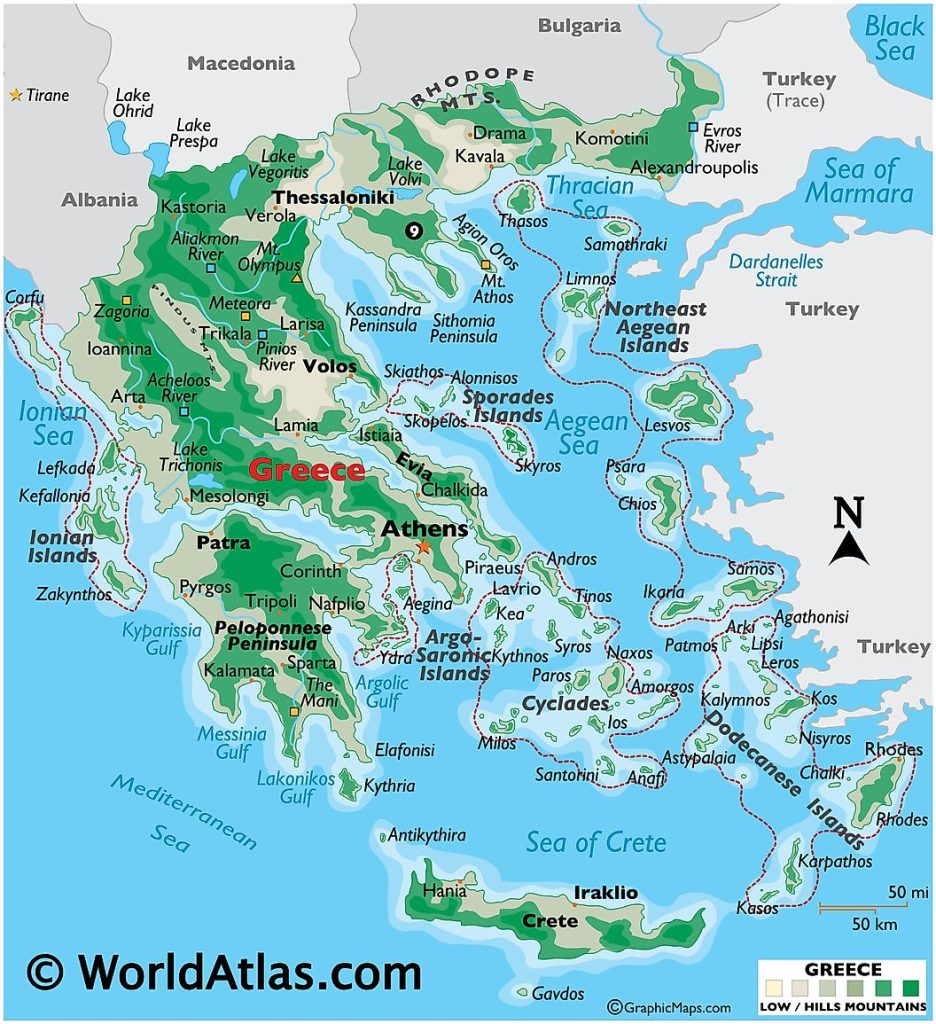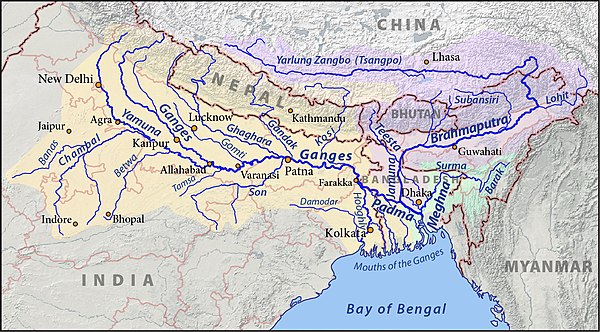CONTENTS
- India-Greece Bilateral Relations
- Cleaning the Ganges
India-Greece Bilateral Relations
Context:
The forthcoming state visit of Greek Prime Minister Kyriakos Mitsotakis to New Delhi on February 21-22 marks a crucial step in the development of a strategic relationship between India and Greece. This process was initiated with the historic visit of Indian Prime Minister Narendra Modi to Greece in August 2023, generating significant enthusiasm in Greece at the highest political levels and among business leaders who recognized the considerable opportunities offered by a strategic partnership with India.
Relevance:
GS-2
- Bilateral Groupings and Agreements
- Groupings and Agreements Involving India and/or Affecting India’s Interests
Mains Question:
The political determination to move Greece-India ties forward is linked to the view by Athens that India is both an old and traditional friend, and a rising power. Analyse. (15 Marks, 250 Words).

Security and Stability:
- The significance of security and stability is paramount for both Greece and India, as they find themselves strategically positioned in regions that are geopolitically sensitive. They are not only crucial to the global system but are also prone to geopolitical volatility.
- Recent events in the Red Sea highlight that the well-being of the East Mediterranean region, where Greece is situated, is intricately tied to the security, stability, and prosperity of the Indian Ocean region.
- There is a heightened awareness among the political leadership in India and Greece about the compelling strategic reasons and the urgency to establish a strategic relationship between the two countries.
- This recognition stems from the understanding that the security, stability, and prosperity of their respective regions are interconnected, emphasizing the need for collaboration and cooperation between Greece and India.
- Greece perceives India not only as an old and traditional friend but also as a rising great power in the rapidly evolving global landscape.
- Accompanying Mr. Mitsotakis will be a high-level Greek business delegation, comprising leaders who view India not only as a gateway to Asia but also as a manufacturing base for their global operations.
Cooperation at Various Levels:
- In anticipation of the visit, Mr. Mitsotakis expressed his determination to enhance bilateral ties and collaboration across various domains.
- He emphasized that “India will find no better gateway to Europe than my country, and for Greece, there is no better gateway to Asia than a close strategic relationship with India.”
- Collaboration across various fronts, encompassing strategic, military, and business aspects, has been progressing steadily, albeit at a measured pace.
- Over the years, the Indian Navy and Indian Air Force have engaged in joint exercises with the Greek armed forces, with reciprocal exercises in the planning stages.
- Business interactions have also been evolving. For instance, an Indian construction company is collaborating with a prominent Greek construction firm in constructing a new airport on the island of Crete.
- Notably, a significant Greek systemic bank has partnered with a major Indian financial institution to globally distribute mutual fund products.
- Another noteworthy development is the substantial long-term investment in Greece by Indian-Canadian billionaire Prem Watsa, the founder and CEO of Fairfax Financial Holdings.
Way Forward:
- With the economic reforms implemented by the Mitsotakis government in the last five years propelling the Greek economy toward a more sustainable growth trajectory, Greece is strategically positioning itself as the dependable eastern flank of both the European Union (EU) and the North Atlantic Treaty Organization in the Eastern Mediterranean.
- Simultaneously, as Greece develops its defense industry, the prospect of establishing the India-Middle East-Europe Economic Corridor (IMEEC) is becoming increasingly significant.
- This corridor aims to enhance economic connectivity, and it is anticipated that Greek and Indian businesses will discover numerous compelling reasons to collaborate.
- Greece, a staunch advocate for deeper EU-India relations, is actively working towards the swift conclusion of the EU-India bilateral trade and investment agreement (BTIA).
- This initiative is poised to serve as an additional catalyst for strengthening bilateral economic ties between Greece and India.
- There is considerable potential for expanding connections between Greece and India, emphasizing the importance of fostering stronger people-to-people ties to preserve the heritage of their ancient linkages.
- It is crucial to make efforts to maintain familiarity with each other even as both Greece and India undergo modernization. This can be achieved through increased university student exchange programs, enhanced cultural exchanges, and greater cooperation in the media.
- Collaborative efforts between think tanks in both countries should focus on building more scholarly connections, and there should be a concerted effort to establish additional travel links between the two nations.
Conclusion:
The frequent exchange of visits by political leaders from Greece and India within a short time frame not only underscores their determination to advance the relationship but also highlights the urgency they attribute to this task. The onus now falls on government policymakers and businesses to follow this lead. The year 2024 holds particular significance for the world and Europe, emerging as a critical period in the development of the strategic partnership between Greece and India.
Cleaning the Ganges
Context:
The Ganges River, often referred to as ‘Ma Ganga’ by devout Hindus, holds significant importance in Hindu culture and is believed to have divine origins as per sacred texts. Despite its revered status, the Ganges faces a critical threat – pollution. It is not just a river; it is a lifeline, yet its waters are severely contaminated, posing a risk to the health and well-being of millions.
Relevance:
GS-1
Water Resources
GS-3
- Conservation
- Environmental Pollution & Degradation
Mains Question:
With sewage and industrial toxins contaminating its waters, the Ganga, again faces an urgent call to action. Discuss how effective have the initiatives to reduce pollution and ensure the rejuvenation of the Ganges been. Also suggest a way forward strategy in this regard. (15 Marks, 250 Words).
About the Ganges:
- The Ganga is created by the convergence of six headstreams and their five confluences. The Alaknanda River meets the Dhauliganga River at Vishnuprayag, the Nandakini River at Nandprayag, and the Pindar River to form the main stream of the Ganga.
- The Bhagirathi, considered the source stream, originates at the foot of the Gangotri Glacier, specifically at Gaumukh, with an elevation of 3892m. As it spans out into the 350km wide Ganga delta, it ultimately flows into the Bay of Bengal.
- The river is referred to as Ganga from Devapryag, and it joins the Yamuna at Allahabad as it emerges from the hills into the plain area.
- Near the Rajmahal Hills, it turns southeast, and at Farraka, it splits into Bhagirathi-Hugli in West Bengal and Padma-Meghna in Bangladesh, ceasing to be known as the Ganga after Farraka. The Brahmaputra, also known as the Jamuna in this region, joins Padma-Meghna.
- The total length of the Ganga river, measured along the Hugli, from its source to its mouth is 2,525 km.
- Significant towns along its course include Haridwar, Kanpur, Soron, Kannauj, Allahabad, Varanasi, Patna, Ghazipur, Bhagalpur, Mirzapur, Ballia, Buxar, Saidpur, and Chunar.

Pollution of the Ganges:
Causes:
- The rapid increase in India’s population, along with swift urbanization and industrialization, has transformed the Ganges into a dumping ground for toxins, sewage, and industrial waste.
- This issue is particularly acute in areas such as Kanpur and Varanasi, where human activities directly contribute to elevated pollution levels.
- Inadequate sewage treatment facilities result in the substantial release of untreated waste into the Ganges.
- Additionally, industrial pollution exacerbates the problem, as tanneries, distilleries, and other industries introduce toxic pollutants into the river.
- The relentless growth of the population, along with improving living standards and rapid industrial and urban development, has exposed the vulnerability of our water resources, with rivers bearing the brunt of this degradation.
- Adding to this challenge are the looming threats of global climate change, the melting of glaciers affecting the Ganges’ flow, and the adverse effects of infrastructure projects in its upper reaches, all requiring a comprehensive and urgent response.
- The industrial sector also significantly contributes to Ganges pollution, accounting for approximately 20% of the overall pollution volume. However, due to the toxic and non-biodegradable nature of industrial waste, its impact is disproportionately severe.
- Tanneries in Kanpur, along with distilleries, paper mills, and sugar mills in the Kosi, Ramganga, and Kali river catchments, collectively contribute to the pollution burden, affecting water sources relied upon by an estimated 600 million people.
Impact:
- The deterioration in water quality directly impacts communities, with specific sections of the Ganges now considered unsuitable even for basic activities such as bathing.
- The repercussions are severe, rendering the water unsuitable for even basic activities like bathing, let alone consumption.
- The extent of pollution is alarming, with reports indicating significant contamination throughout the river’s course.
- Kanpur, located in Uttar Pradesh, serves as a poignant example of this pollution crisis. Being one of the most densely populated cities in the state, its residents engage in daily activities like washing clothes, bathing, and even disposing of waste directly into water bodies, exacerbating pollution levels. Following closely behind is Varanasi, another significant contributor to Ganges pollution.
- A damning report has disclosed that 37 out of the 41 sites along the river are grappling with moderate to severe pollution levels.
- Surprisingly, only the water at the Haridwar Barrage complies with drinking water standards, making it a rare example of cleanliness amid widespread contamination.
- This harsh reality underscores the immediate need for concerted efforts to safeguard and restore the pristine waters of the Ganges.
- In the Ganga basin, an astonishing 12,000 million litres per day (MLD) of sewage are generated, yet the current treatment capacity is a mere 4,000 MLD.
- This stark disparity results in approximately 3,000 MLD of untreated sewage being discharged directly into the Ganges from towns categorized as Class I and II along its banks.
- Despite endeavors, only around 1,000 MLD of treatment capacity has been established so far.
- Despite efforts to monitor and control pollution, the majority of locations along the river still fall short of meeting even basic water quality standards.
Way Forward:
- Immediate action is imperative in the current situation. The Namami Gange program, initiated by the Indian government, represents a significant stride toward rejuvenating the river.
- With billions of dollars allocated to sewage treatment facilities and sewer line construction, the program aims to tackle the root causes of pollution and restore the Ganges to its original state.
- The success of the Namami Gange program depends on effective implementation and sustained efforts to combat pollution.
- To date, the program has incurred expenditures exceeding 328 billion rupees ($3.77 billion), allocating funds for the establishment of over 170 new sewage facilities and laying approximately 5,211 kilometers of sewer lines—a distance equivalent to crossing the Atlantic Ocean.
- This initiative serves as an intriguing benchmark in the global effort to purify water bodies. If the challenge of cleansing a river considered sacred by hundreds of millions proves insurmountable, the prospects for addressing similar tasks elsewhere come into question.
Conclusion:
The Ganges is not solely India’s river; it symbolizes hope and spirituality for millions worldwide. Its purification is not merely an environmental concern but a moral imperative. As the world contends with the repercussions of pollution and climate change, the fate of the Ganges acts as a litmus test for our collective commitment to safeguarding our planet’s precious resources. If we falter in cleansing the Ganges, what hope do we hold for the well-being of our other rivers and seas?





